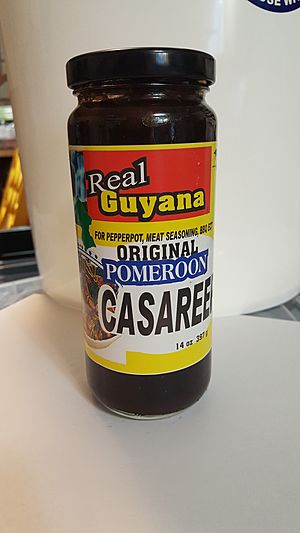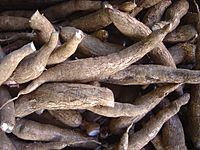Cassareep facts for kids
Cassareep is a thick, dark liquid made from the cassava root. It often has extra spices added. People use it as a base for many sauces, especially in a famous dish called Guyanese pepperpot. Besides giving food flavor and a nice brown color, many believe it helps keep food fresh for longer.
Contents
How is Cassareep Made?
Cassareep comes from the juice of the bitter cassava root. Raw cassava juice is poisonous. It contains a natural chemical that turns into a very harmful gas when it touches water. But don't worry! This harmful gas disappears quickly when heated. This is why cassava must be cooked properly before eating.
To make cassareep, the cassava juice is boiled. It boils until its volume is cut in half. It becomes thick, like molasses. Then, spices are added for flavor. These often include cloves, cinnamon, salt, sugar, and cayenne pepper.
Traditional Boiling Pots
In the past, cassareep was often boiled in a special pot. This pot was called a "pepper pot." It would soak up all the delicious flavors. Then, it would pass those flavors on to other foods cooked in it, like rice or chicken.
Most cassareep is sent out from Guyana to other countries. People in Guyana traditionally brought it to towns in bottles. You can find it bottled in places like the United States. Even though cassava root is grown a lot in Africa, cassareep is not made there.
What is Cassareep Used For?
Cassareep is used for two main reasons. First, it has a special flavor. Second, it helps preserve food.
Flavoring Dishes
Cassareep is a key ingredient in Guyanese pepperpot. It gives the dish its unique sweet and slightly bitter taste. It can also be added to other foods. It makes them taste rich and savory, like a strong beef soup.
Keeping Food Fresh
Cassareep has a special quality. It acts like an antiseptic. This means it can help keep food from spoiling. People say that food can be kept cooking for a very long time if cassareep is added regularly. There's a famous story about a pepperpot in Grenada. It was supposedly kept cooking for over 100 years! Dutch farmers in Suriname also reportedly kept their pepperpots cooking for many years.
Did Cassareep Have Medical Uses?
People used to think cassareep had healing powers. They believed its antiseptic qualities could help with health problems. For example, in the late 1800s, some thought it might help treat eye issues. These included problems like corneal ulcers (sores on the eye) and conjunctivitis (pink eye).
However, scientists did laboratory tests on cassareep. A professor named Attfield, who studied chemistry, found no proof that it had any medical benefits. Even so, some old medical journals still talked about its possible uses.



